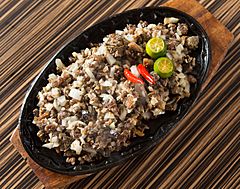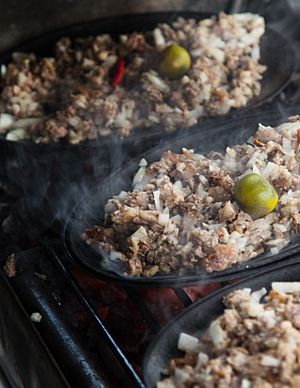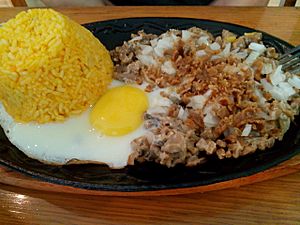Sisig facts for kids

Kapampangan sisig served on a hot plate.
|
|
| Alternative names | Sisig |
|---|---|
| Course | Main course, snack, salad |
| Place of origin | Philippines |
| Region or state | Pampanga |
| Created by | Modern sisig – Lucia Cunanan; original sisig – no attributed creator |
| Serving temperature | Hot |
| Main ingredients | Pork jowls, ears, sometimes brain and liver, onions and chili |
| Variations | Chicken sisig, beef sisig, squid sisig, tuna or bangus sisig or other fish, tofu sisig |
| 293 kcal (1227 kJ) | |
| Similar dishes | Kilawin, tokwa't baboy |
Sisig is a popular Filipino dish. It is usually made from parts of a pig's face and belly. It also often includes chicken liver. The dish is seasoned with calamansi (a small citrus fruit), onions, and chili peppers. Sisig comes from the Pampanga region in Luzon, Philippines.
Sisig is a very important part of Kapampangan cooking. The city of Angeles, Pampanga even made a rule in 2017. This rule declared "sizzling sisig babi" (pork sisig) a special heritage of the city.
Where Did Sisig Come From?
The word sisig was first written down in 1732. A monk named Diego Bergaño recorded it in his dictionary. He said sisig meant a "salad" made with green papaya or green guava. This salad was eaten with salt, pepper, garlic, and vinegar.
The word mannisig is still used today. It means eating green mangoes dipped in vinegar. Over time, sisig also came to mean a way of preparing meat or fish. This method involved soaking the food in a sour liquid like lemon juice or vinegar. Then, it was seasoned with salt, pepper, and other spices.
Many people believe that using pig's heads in sisig started because of extra meat from Clark Air Base. This was an American military base in Angeles City. Pig heads were cheap or even free. This is because the American Air Force personnel did not use them for their meals.
A woman named Aling Lucing became very famous for her sisig. She started grilling pig's ears and adding pig's cheeks. She learned this recipe from a neighbor. Later, Benedict Pamintuan had a great idea. He used a sizzling plate to serve sisig. This kept the pork fat from getting cold and hard. Sisig still has many different versions today. Recipes can change from city to city, and even from family to family.
The "Sisig Queen"
Lucia Cunanan, also known as "Aling Lucing," is famous for changing sisig. She started grilling the pig's ears and using the cheeks. The Philippine Department of Tourism recognized her restaurant. They said "Aling Lucing's" made Angeles the "Sisig Capital of the Philippines" in 1974.
Aling Lucing's special sisig was created in the mid-1970s. She served grilled and chopped pig ears and cheeks. These were seasoned with vinegar, calamansi juice, chopped onions, and chicken liver. It was always served on hot plates. Today, you can find many kinds of sisig. Some popular ones include chicken, squid, tuna, or tofu sisig.
How is Sisig Made?
According to Aling Lucing's recipe, making sisig has three main steps. First, the pig's head is boiled. This helps to remove hairs and make the meat tender. Second, parts of the head are chopped and then grilled. Finally, chopped onions are added. The dish is then served on a sizzling hot plate.
Some versions of sisig might include pork or chicken liver. Other additions can be eggs, ox brains, or chicharon (crispy pork cracklings). Sometimes, mayonnaise is also added. However, some traditional chefs in Pampanga do not like these additions. They feel it changes the original sisig too much. Recently, chefs have also tried making sisig with other ingredients. These include chicken, squid, tuna, and tofu.
Sisig Festivals!
The annual "Sisig Festival" is held every December in Angeles, Pampanga. This festival celebrates the famous Kapampangan dish. It began in 2003. The mayor, Carmelo Lazatin, made it an annual event in 2004. The festival helps to show off the city's amazing cooking skills.
The festival also has a cooking contest. Chefs compete to make the best sisig dishes. In 2006, a restaurant chain called Congo Grille won the contest.
The festival stopped for a while in 2008 after Aling Lucing passed away. In 2014, Ayala Malls's Marquee Mall included the festival. They made it part of their annual Big Bite! Northern Food Festival. This food festival happens every October or November.
The Angeles City Tourism Office brought the festival back on April 29, 2017. This return was part of the Philippine Department of Tourism's Flavors of the Philippines campaign. The revived event is now called "Sisig Fiesta." It takes place on Valdes Street in Angeles. This street is also known as "Crossing" because it used to be a railroad track. This is where Aling Lucing first created her famous dish. The "Sisig Fiesta" is a one-day event. It features many sisig samples, sisig and BBQ stalls, and cooking shows. Celebrity chefs also give demonstrations. The festival also showcases the cooking talent of people from Angeles through competitions.
See also
 In Spanish: Sísig para niños
In Spanish: Sísig para niños



